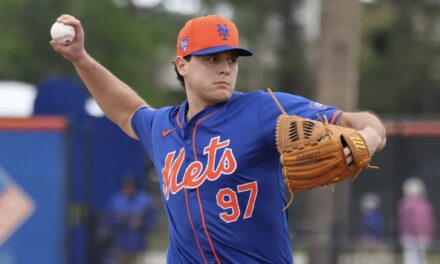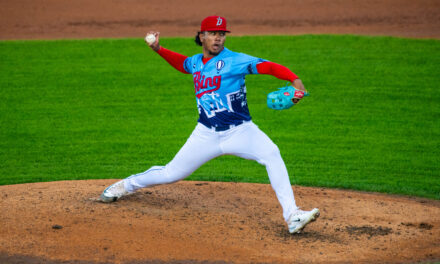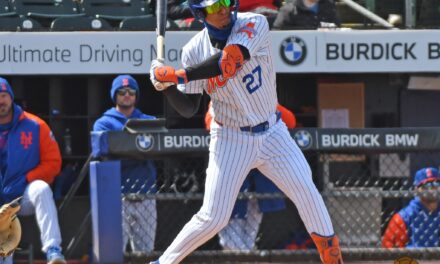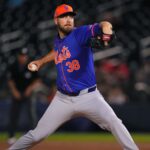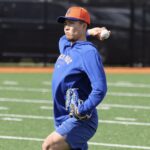Keith Law, of ESPN.com, has released his annual Top 100 Prospects. The following are his scouting reports for the four Mets prospects who cracked his list.
Jenrry Mejia #23 – Mejia entered 2009 with no experience above short-season leagues, but finished it in Double-A despite missing time in the middle of the year with a strained finger on his pitching hand. He has top-of-the-rotation stuff, but is just 20 with the command you’d expect to see in a live-armed teenager with barely 200 innings in pro ball. His fastball sits at 93-96 and will tick higher, and the ball sometimes shows natural cutting action toward left-handed hitters. His changeup is his best off-speed pitch and, at 85-87 mph with good tail, looks like a soft two-seamer. His curveball is very inconsistent, but at its best, it’s plus with good two-plane break and depth in the upper 70s. He’s thick but not tall, and his slot is just below 3/4 — so he has to work on staying on top of the ball, and the finger injury reduced his already below-average command. That said, he’s 20 and has shown he can get advanced hitters in Double-A out. If the Mets slow him down a little and let him spend all of 2010 (and maybe some of 2011) in the minors to improve his command and the consistency of his changeup and curve, they have a chance for a No. 1 or No. 2 starter.
Wilmer Flores #41 – Flores, as predicted, broke with a full-season club in 2009 and held his own despite playing most of the year at 17. He has very quick wrists and is short to the ball with good finish. The ball flies off his bat, especially in BP, in which he shows the promise of future plus power, and in games he has already shown that he can square balls up against pitchers two or three years his senior. In fact, of players with at least 400 at-bats in the Sally League in 2009, only one hitter had fewer strikeouts than Flores did. His main deficiency as a player is very slow feet, even though he’s not thickly built, and he has no shot to stay at shortstop and little shot of handling third base, which means he’ll end up at first base or in an outfield corner, although there’s an excellent chance his bat plays in any of those positions.
Ike Davis #64 – Davis’ mediocre debut in 2008 turned out to be a red herring, as he finished his first full season in 2009 in Double-A and isn’t far from reaching the majors. He has raw power, especially dead pull power, and showed that he can murder a fastball and lay off a lot of pitches out of the zone against right-handed pitchers. On the downside, Davis doesn’t hit left-handed pitching at all, and even against right-handers struggles to recognize off-speed stuff. He’s a reasonably good athlete who can handle first base and actually has a plus arm — he was 92-94 mph as a reliever in college — although that’s less relevant at the position. A full year in Double-A/Triple-A to work on pitch recognition and on improving his approach against left-handers is probably critical for his future as an everyday player, but he has a chance to be an above-average one if he can shed the “platoon player” tag with more reps.
Fernando Martinez #73 – Martinez has one of the biggest drops of anyone on this list (from last year’s list), but I’m not down on Martinez’s offensive potential — the ball still comes off his bat incredibly well, comparable to Starlin Castro, who sits in the Top 25 of this list because of that skill — and I could have left Martinez in the Top 25 and justified it. The problems with “F-Mart,” aside from the fact that Mets fans decided to give him a nickname more appropriate for a farm-equipment discount store, aren’t about baseball skills. He continues to have trouble staying healthy, and there’s a real risk of Chris Snelling disease here, with lack of playing time limiting his development; he’s never had more than 400 plate appearances in any season, and even including winter ball this offseason, when he was just back from knee surgery, he had fewer than 300 PAs in ‘09. Martinez has also had his work ethic and conditioning called into question, including a visible lack of effort more than once at the big league level last year. Very few players can coast to major league stardom on talent alone, and Martinez needs to grow up — he’s still just 21 years old — to turn himself into an elite corner-outfield bat. (It looks like Martinez has exactly 45 days on the Mets’ active roster, which would make him eligible for the Rookie of the Year award in 2010, as well as for this list. If he had just one more day on the active roster, he’d no longer be eligible.)
Law also lists his version of the top ten prospects in the Mets organization, which he ranked #15 overall last week.
1.Jenrry Mejia
2.Wilmer Flores
3.Ike Davis
4.Fernando Martinez
5.Brad Holt
6.Jon Niese
7.Josh Thole
8.Reese Havens
9.Jefry Marte
10.Juan Urbina
Unlike the recently released MLB Top 50 Prospects which featured no Mets prospects, Law has both Mejia and Flores among in his first fifty picks. I’m a bit surprised though, that both Jeurys Familia and Ruben Tejada were left off his organizational top ten.


